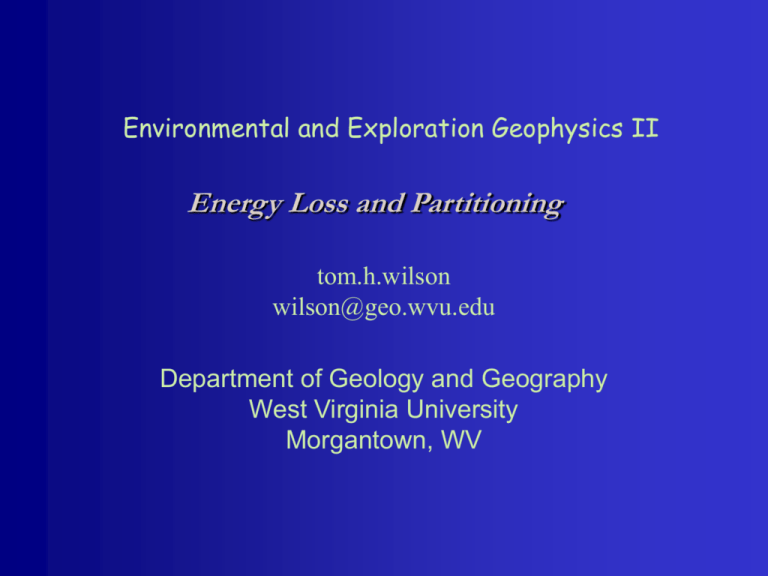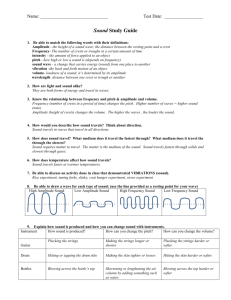Energy Loss and Partitioning
advertisement

Environmental and Exploration Geophysics II Energy Loss and Partitioning tom.h.wilson wilson@geo.wvu.edu Department of Geology and Geography West Virginia University Morgantown, WV Be sure to do the following for all exercises 1) label all plotted curves, 2) label all relevant points and …. 3) Where appropriate, provide a paragraph or so of discussion regarding the significance and origins of the interrelationships portrayed in the resultant time-distance plots. In exercise II for example, how do you account for the differences in the two reflection hyperbola? How is their appearance explained by the equations derived in class for the reflection time-distance relationship. Re: 3) Discussion - In Exercise III, explain the differences observed in the arrival times of the reflection and diffraction observed in the shot record. Why does the diffraction event drop below the reflection? As noted earlier - accurately portray the arrival times at different offsets or surface locations. Your plots should serve as an accurate representation of the phenomena in question. Let’s come back to ray-tracing concepts for a minute and consider the diffraction problem in a little more detail. How would you set up the mathematical representation of diffraction travel time as a function of source receiver distance? We’ve taken a few shortcuts here, but we need go no further. We have defined the basic features of the diffraction and we can see how in subtle ways it will differ from that of the reflection. t x2 V12 4h12 V12 Although the time intercept remains the same - how do the shapes of the reflection hyperbola differ in these two cases? Can you pick out the direct arrival? Can you pick out the refraction arrivals? How many critical refractions are there? How would you determine the refraction velocity? How would you determine the air wave or direct arrival velocity? To calculate the speed of sound go to http://www.measure.demon.co.uk/Acoustics_Software/speed.html Discussion of Chapter 3: What happens to the seismic energy generated by the source as it propagates through the subsurface? Basic ConceptsEnergy - The ability to do work. It comes in two forms potential and kinetic Work expended (W) equals the applied force times the distance over which an object is moved. Power is the rate at which work is performed. As a mechanical disturbance or wavefield propagates through the subsurface it moves tiny particles back and forth along it path. Particle displacements are continually changing. Hence, it is more appropriate for us to consider the power, or the rate at which energy is being consumed at any one point along the propagating wavefront. W (the work) Fx (force times displacement) dW Power dt The rate of change of work in unit time. dW dFx dx F Fv dt dt dt This force is the force exerted by the seismic wave at specific points along the propagating wavefront. and since force is pressure (p) x area (A), we have dW Power Fv pvA dt The power generated by the source is PS. This power is distributed over the total area of the wavefront A so that PS pvA We are more interested to find out what is going on in a local or small part of the wavefield and so we would like to know * Note we are trying to quantify the effect of wavefront spreading at this point and are ignoring heat losses. PS pv A Over what surface area is the energy generated by the source distributed? Area of a hemisphere is 2R2 hence - pv PS 2R 2 This is the power per unit area being dissipated along the wavefront at a distance R from the source. (Recall p is pressure, v is the particle velocity, PS magnitude of the pressure disturbance generated at the source and R is the radius of the wavefront at any given time. In the derivation of the acoustic wave equation (we’ll spare you that) we obtain a quantity Z which is called the acoustic impedance. Z = V, where is the density of the medium and V is the interval velocity or velocity of the seismic wave in that medium. Z is a fundamental quantity that describes reflective properties of the medium. We also find that the pressure exerted at a point along the wavefront equals Zv or Vv, where v is the particle velocity - the velocity that individual particles in the disturbed medium move back and forth about their equilibrium position. pv Vv v pv Zv 2 Combining some of these ideas, we find that v, the particle displacements vary inversely with the distance traveled by the wavefield R. 2 Zv v Ps 2R 2 Ps Z 2R 2 1 Ps v R Z 2 •We are interested in the particle velocity variation with distance since the response of the geophone is proportional to particle (or in this case) ground displacement. So we have basically characterized how the geophone response will vary as a function of distance from the source. •The energy created by the source is distributed over an ever expanding wavefront, so that the amount of energy available at any one point continually decreases with distance traveled. •This effect is referred to as spherical divergence. But in fact, the divergence is geometrical rather than spherical since the wavefront will be refracted along its path and its overall geometry at great distances will not be spherical in shape. The effect can differ with wave type. For example, a refracted wave will be confined largely to a cylindrical volume as the energy spreads out in all directions along the interface between two intervals. z R The surface area along the leading edge of the wavefront is just 2Rz. Hence (see earlier discussion for the hemisphere) the rate at which source energy is being expended (power) per unit area on the wavefront is Ps Zv A 2 Remember Zv2 is just Ps Zv 2Rz 2 Following similar lines of reasoning as before, we see that particle velocity Ps v R Ps v R The dissipation of energy in the wavefront decreases much less rapidly with distance traveled than does the hemispherical wavefront. This effect is relevant to the propagation of waves in coal seams and other relatively low-velocity intervals where the waves are trapped or confined. This effect also helps answer the question of why whales are able to communicate over such large distances using trapped waves in the ocean SOFAR channel. Visit http://www.beyonddiscovery.org/content/view.page.a sp?I=224 for some info on the SOFAR channel. See also - http://www.womenoceanographers.org/doc/MTolstoy/Les son/MayaLesson.htm To orient ourselves, you can think of the particle velocity as the amplitude of a seismic wave recorded by the geophone - i.e. the amplitude of one of the wiggles observed in our seismic records. The amplitude of the seismic wave will decrease, and unless we correct for it, it will quickly disappear from our records. Since amplitude (geophone response) is proportional to the square root of the pressure, we can rewrite our divergence expression as Ps Ar r As Ar r Thus the amplitude at distance r from the source (Ar) equals the amplitude at the source (AS) divided by the distance travelled (r). This is not the only process that acts to decrease the amplitude of the seismic wave. Absorption When we set a spring in motion, the spring oscillations gradually diminish over time and the weight will cease to move. In the same manner, we expect that as s seismic wave propagates through the subsurface, energy will be consumed through the process of friction and there will be conversion of mechanical energy to heat energy. We guess the following - there will be a certain loss of amplitude dA as the wave travels a distance dr and that loss will be proportional to the initial amplitude A. i.e. dA AS dr How many of you remember how to solve such an equation? dA(r ) AS dr dA(r ) dr AS is a constant referred to as the attenuation factor In order to solve for A as a function of distance traveled (r) we will have to integrate this expression In the following discussion,let A0 AS A dA r A0 A 0dr ln A ln A0 r ln A ln A0 r A ln r A0 ln e A A0 er A er A0 A A0er Mathematical Relationship A(r ) A0er Graphical Representation A(r ) A0er - the attenuation factor is also a function of additional terms is wavelength, and Q is the absorption constant Q 1/Q is the amount of energy dissipated in one wavelength () - that is the amount of mechanical energy lost to friction or heat. Q is also a function of interval velocity, period and frequency r A(r ) A0e Q A(r ) A0e QV r is just the reciprocal of the frequency so we can also write this relationship as f A(r ) A0e QV r Smaller Q translates into higher energy loss or amplitude decay. A(r ) A0e f QV r increase f and decrease A Higher frequencies are attenuated to a much greater degree than are lower frequencies. When we combine divergence and absorption we get the following amplitude decay relationship A0 r A(r ) e r The combined effect is rapid amplitude decay as the seismic wavefront propagates into the surrounding medium. We begin to appreciate the requirement for high source amplitude and good source-ground coupling to successfully image distant reflective intervals. But we are not through - energy continues to be dissipated through partitioning - i.e. only some of the energy (or amplitude) incident on a reflecting surface will be reflected back to the surface, the rest of it continues downward is search of other reflectors. The fraction of the incident amplitude of the seismic waves that is reflected back to the surface from any given interface is defined by the reflection coefficient (R) across the boundary between layers of differing velocity and density. Z 2 Z1 R Ainc Z1 Z 2 Arefl Z 2 Z1 R Ainc Z1 Z 2 Arefl Z1 and Z2 are the impedances of the bounding layers. 2V2 1V1 1V1 2V2 Z 2 Z1 R Z1 Z 2 The transmitted wave amplitude T is T 1 R Z1 Z 2 Z 2 Z1 T Z1 Z 2 Z1 Z 2 2 Z1 T Z1 Z 2 At a distance of 100 m from a source, the amplitude of a P-wave is 0.1000 mm, and at a distance of 150 m the amplitude diminishes to 0.0665 mm. What is the absorption coefficient of the rock through which the wave is traveling? (From Robinson and Coruh, 1988) Any Questions?








